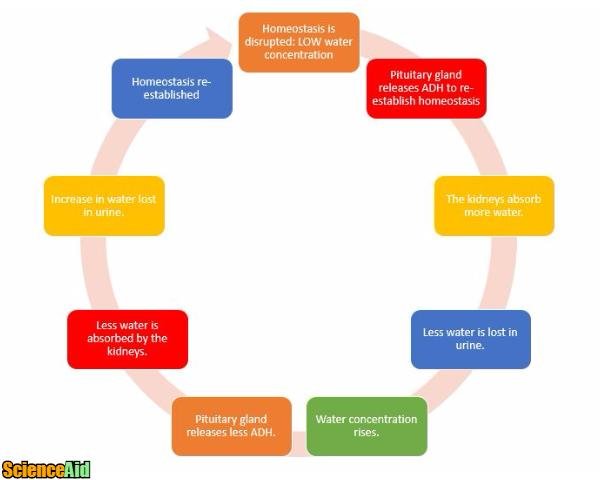Homeostasis: Negative Feedback, Body Temperature, Blood Glucose
Edited by Sharingknowledge, SarMal
Questions and Answers
Draw a diagram to illustrate the role of negative feedback in homeostasis. On your diagram explain the role of receptors, control center, and effectors?
I am trying to answer this question for my assignment, however, I do not know where to start, would you be able to advise me on How can I start this question or give me pointers please. . .
As the article demonstrates, keeping water levels, temperature and glucose levels as constant as possible (homeostasis) are vital to health. When homeostasis is disrupted, corrective mechanisms are instigated that regulate the disrupted levels and move them back to the appropriate level. Moving these levels back to the appropriate level is an example of negative feedback. Negative feedback is a control system that responds when homeostasis is disrupted in order to regulate the conditions and re-establish homeostasis.
Conversely, positive feedback is a control system that identifies when homeostasis is disrupted but rather than re-establish homeostasis, positive feedback actually pushes the body further away from homeostasis. Positive feedback is less common, however, an example is the release of Oxytocin during the later stages of pregnancy.
Osmoregulation is an excellent model to demonstrate negative feedback. Homeostasis is necessary to ensure water concentration is regulated. Water concentration is controlled by the pituitary gland with the production and distribution of ADH (anti-diuretic hormone) to the kidneys. ADH regulates the permeability of the tubules in the kidneys, regulating the amount of water absorbed in the blood and the amount of water lost as urine. If the water concentration level is too low (dehydration), the water will be reabsorbed into the blood. If the water concentration level rises, the water is disposed of via urine. Negative feedback is a system that is constantly running in order to maintain a regulated water level - homeostasis. Osmoregulation can be illustrated in the following diagram.
Referencing this Article
If you need to reference this article in your work, you can copy-paste the following depending on your required format:
APA (American Psychological Association)
Draw a diagram to illustrate the role of negative feedback in homeostasis. On your diagram explain the role of receptors, control center, and effectors? . (2017). In ScienceAid. Retrieved Apr 26, 2024, from https://scienceaid.net/Draw_a_diagram_to_illustrate_the_role_of_negative_feedback_in_homeostasis_On_your_diagram_explain_the_role_of_receptors_control_centre_and_effectors
MLA (Modern Language Association) " Draw a diagram to illustrate the role of negative feedback in homeostasis. On your diagram explain the role of receptors, control center, and effectors? ." ScienceAid, scienceaid.net/Draw_a_diagram_to_illustrate_the_role_of_negative_feedback_in_homeostasis_On_your_diagram_explain_the_role_of_receptors_control_centre_and_effectors Accessed 26 Apr 2024.
Chicago / Turabian ScienceAid.net. " Draw a diagram to illustrate the role of negative feedback in homeostasis. On your diagram explain the role of receptors, control center, and effectors? ." Accessed Apr 26, 2024. https://scienceaid.net/Draw_a_diagram_to_illustrate_the_role_of_negative_feedback_in_homeostasis_On_your_diagram_explain_the_role_of_receptors_control_centre_and_effectors.
If you have problems with any of the steps in this article, please ask a question for more help, or post in the comments section below.
Comments
Article Info
Recent edits by: Sharingknowledge
